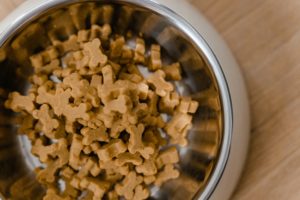
The pet food industry is growing, reaching a record $103.6 billion dollars in 2022, and is expected to rise in the coming years. Even during the COVID-19 pandemic, owners actually spent 20% to 25% more on their fur baby’s food.
It’s a big opportunity for pet food manufacturers, but unprecedented growth does come with substantial challenges.
Plants have to keep up with the higher production, and meet strict quality standards—not just from discerning pet owners, but industry and state regulatory boards. The Food Safety Modernization Act (FSMA) has even tightened its requirements for the animal food industry, including a hazard plan to prevent spoilage and contamination, and regular plant inspections.
Problems that Affect Pet Food Production
Proper material flow is essential for meeting those goals. It can prevent many problems that can slow down production, and compromise the quality and safety of the product. Sluggish flow and stagnant material can:
- Cause contamination and spoilage. Microorganisms and bacteria can grow in trapped material, or grow on the vessel itself.
- Compromise blend uniformity. Sluggish and erratic flow compromises the proportion of materials, affecting the pet food’s quality and nutritional value.
- Lead to production delays. Any clogged vessel affects downstream processes and can lead to shutdowns for manual cleaning.
- Increase costs. Delayed production can increase manpower hours. Spoiled material and off-spec batches need to be thrown away, and even a single “bad batch” that escapes quality control can lead to product recalls.

Bulk Powders and Solids Used in Pet Food Manufacturing
Pet food is made from meat and meat by-products, cereal grains such as soybean meal and cornmeal, and liquids such as broth, blood, or water. Other materials may be added to improve palatability, consistency, and texture:
- Cereal grains such as cornmeal, soybean meal, barley, bran flakes, cracked wheat
- Starches and thickeners like cellulose, carrageenan
- Flavor enhancers such as fat, fish solubles, protein, or concentrated flavors
- Vitamin and mineral supplements
- Proteinaceous adhesives such as collagen and casein
- Plasticizing agents
- Binders
- Emulsifiers
- Antioxidants to slow down oxidation and rancidity
- Preservatives to prevent the growth of bacteria and mold
Unfortunately, many of these materials can be very difficult to handle, because of a tendency to form fines, segregate during mixing, or clump when exposed to moisture.
These materials can become compact during storage, and form problematic flow patterns in silos and hoppers. Bridging, arching, and ratholing are very common. And for moist or sticky formulas such as canned food, caking and material residue can plague every step of production.
AirSweep®: The Best Flow Aid for Pet Food
Pet food companies – as well as food and agriculture companies that have similar concerns – use AirSweep to improve material flow.
AirSweep releases high-pressure, high-volume air pulses that sweep all material back into the flow stream. It can be used during production to prevent material blocks and ensure blend uniformity, and between runs to flush vessels completely clean.
AirSweep works with some of the biggest manufacturers of pet food and treats, including one of Canada’s largest dry food manufacturers.
Elmira Pet Products had issues with feed blends bridging in the bottom of the bins. Vibrators and pneumatic hammers didn’t work. Operators still had to hit the bins with sledgehammers and climb into the two-story vessel to clean the receiver.
AirSweep provided on-demand flow and even shortened their cleaning time. They use AirSweep VA-12 units to clear material hang-ups in the dry mix bins, and AirSweep VA-06 units to clear kibble fines above the airlock.
The Proof is in the Flow
AirSweep’s precise air pulses are effective for bulk powders and solids used in the pet food industry. Watch the videos:
AirSweep is also used in other industries to promote on-demand flow of even the most challenging bulk materials. Contact us for more information, or to request a material flow test.





Comments are closed